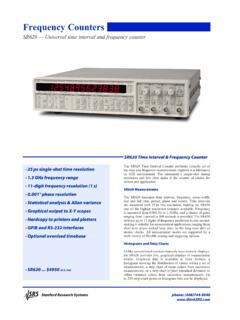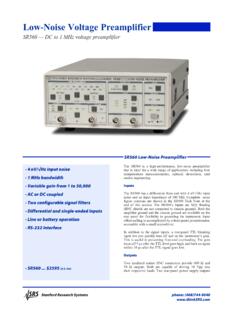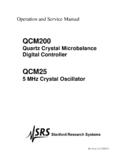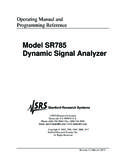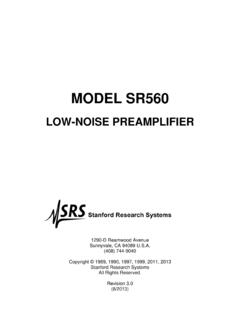Transcription of SG380 Series RF Signal Generators - Stanford Research …
1 Revision SG380 Series RF Signal Generators SG382 (DC to GHz) SG384 (DC to GHz) SG386 (DC to GHz) User Manual Stanford Research Systems SG380 Series RF Signal Generators Certification Stanford Research Systems certifies that this product met its published specifications at the time of shipment. Warranty This Stanford Research Systems product is warranted against defects in materials and workmanship for a period of one (1) year from the date of shipment. Service For warranty service or repair, this product must be returned to a Stanford Research Systems authorized service facility. Contact Stanford Research Systems or an authorized representative before returning this product for repair. Model numbers This document is the User Manual for three models in the SG380 Series of RF Signal Generators . The SG382, SG384 and SG386 provide front panel outputs of frequencies up to GHz, GHz and GHz respectively.
2 Information in this document is subject to change without notice. Copyright Stanford Research Systems, Inc., 2012, 2017, 2019. All rights reserved. Stanford Research Systems, Inc. 1290-C Reamwood Avenue Sunnyvale, California 94089 Phone: (408) 744-9040 Fax: (408) 744-9049 Printed in the Table of Contents i Stanford Research Systems SG380 Series RF Signal Generators Contents Contents i Safety and Preparation for Use ix Symbols You May Find on SRS Products x Specifications xi Typical Waveforms xx Typical Spectra xxii Quick Start Instructions 1 Introduction 3 Feature Overview 3 Front-Panel Overview 4 Parameter and Units Display 4 Main Output 5 BNC Output 5 Safety and Preparation for Use ix Symbols You May Find on SRS Products x Specifications xi Typical Waveforms xx Typical Spectra xxii Feature Overview 3 Front-Panel Overview 4 Parameter and Units Display 4 Main Output 5 Modulation Modes 6 Parameter Selection and Adjustment 7 Numeric Entry and Secondary Parameters 8 Secondary Functions 10 Power and Status 11 Rear-Panel Overview 13 AC Power 13 Timebase 13 Remote Interfaces 14 Modulation 14 Rear-Panel Optional Outputs 15
3 Introduction 17 Power-On 17 Setting Parameters 17 Frequency 18 Phase 18 Table of Contents ii Stanford Research Systems SG380 Series RF Signal Generators Rel Phase 19 Amplitude and Power 20 DC Offset 21 RF ON/RF OFF 22 Modulation and Sweeps 23 Introduction 23 Modulation Section 24 Modulation Rate 25 Modulation Deviation 25 Modulation Waveform Generator, Inputs and Outputs 26 Amplitude Modulation 28 Frequency Modulation 29 Phase Modulation 33 Pulse and Blank Modulation 35 Phase Continuous Frequency Sweeps 38 I/Q Modulation (Option 3) 40 Secondary (Shift) Parameters 43 REL =0 43 PRBS 43 STEP SIZE 43 Timebase 44 NET 44 GPIB 46 RS-232 47 DATA 47 STATUS 48 LOCAL 49 INIT 49 CAL 49 Factory Default Settings 50 Introduction 53 Interface Configuration 53 Front-Panel Indicators 56 Command Syntax 56 Parameter Conventions 57 Numeric Conventions 57 Abridged Index of Commands 58 Detailed Command List 60 Common Commands 60 Status and Display Commands 63 Signal Synthesis Commands 65 Modulation Commands 68 List Commands 74 Interface Commands 76 Status Byte Definitions 78 Serial Poll Status Byte 78 Standard Event Status Register 79 Instrument Status Register 79 Table of Contents iii Stanford Research Systems SG380 Series RF Signal Generators List Mode 80 List Instrument States 80 Enables/Disables 81 Modulation List States 82 Examples 83 Error Codes 84 Execution Errors 84 Query Errors 85 Device Dependent Errors 85 Parsing Errors 86
4 Communication Errors 87 Other Errors 87 Example Programming Code 88 Overview 93 Equipment Required 93 SG380 Series Self Test 94 Output Power Tests 94 BNC Output Power Test 94 Type-N Output Power Test 95 Frequency Synthesis Tests 97 Frequency Generation Tests 97 Modulation Output Test 98 Modulation Input Test 99 Timebase Calibration 100 Timebase Calibration Test 101 Calibration 102 Option Board Verifications 102 Option 1: Clock Output Test 102 Option 2: RF Doubler Test 104 Option 2: DAC Output Test 105 Option 3: IQ Modulation 106 Conclusions 106 Overview 107 Block Diagram 108 Detailed Circuit Description 110 Front-Panel Display 110 Front-Panel Display EMI Filter 111 Motherboard 111 Timebases 111 LF DDS and 19 MHz Reference 112 Microcontroller and Interface 113 Modulation Processor 114 Modulation ADC and DACs 115 RF DDS 116 RF Block and Rear-Panel Options Interface 117 Power Conditioning 118 Motherboard to RF Block Jumper 118 Table of Contents iv Stanford Research Systems SG380 Series RF Signal Generators RF Output Block 118 RF Synthesizer 119 RF Dividers and Selectors 120 RF I/Q Modulator, Amplifiers and Attenuators 121 RF Output Attenuators 122 BNC Output 122 Power Supply 123 Rear-Panel Options 124 Clock Output (Options 1) 124 RF Doubler (Option 2) 125 I/Q Modulator (Option 3)
5 126 Timebase Options 126 Phase Lock Loop Frequency Synthesizers 127 Phase Noise 128 Increasing Frequency Resolution 129 A Note on Fractional-N Synthesis 129 About YIG Oscillators 129 A New Approach 130 An Example 131 Elimination of Error 132 Conclusion 132 Indicators 5 Modulation Modes 6 Parameter Selection and Adjustment 7 Display Navigation 7 Numeric Entry and Secondary Parameters 8 Stepping Up and Down 8 Step Size 9 Store and Recall Settings 9 Secondary Functions 10 Cancel 11 Power and Status 11 Status Indicators 11 REF / SYNTH 11 INTERFACE 11 POWER 12 Rear-Panel Overview 13 AC Power 13 Timebase 13 10 MHz IN 13 10 MHz OUT 13 Remote Interfaces 14 GPIB 14 RS-232 14 Ethernet 14 Modulation 14 IN 14 OUT 14 Table of Contents v Stanford Research Systems SG380 Series RF Signal Generators Rear-Panel Optional Outputs 15 Option 1: Clock Outputs 15 Option 2: 8 GHz Frequency Doubler 15 Option 3: I/Q Modulator 15 Operation 17 Introduction 17 Power-On 17 Setting Parameters 17 Frequency 18 Phase 18 Rel Phase 19 Amplitude and Power 20 DC Offset 21 RF ON/RF OFF 22 Modulation and Sweeps 23 Introduction 23 Modulation Section 24 Modulation On/Off 24 Modulation Type 24 Modulation Function 24 Modulation Rate 25 Modulation Deviation 25 Modulation Waveform Generator, Inputs and Outputs 26 Linear Modulation 26 Pulse Modulation 26 Linear Noise Modulation 27 Pulse Noise Modulation 27 Modulation Output 27 Amplitude Modulation 28 Setting up Amplitude Modulation: 28 Amplitude Modulation Example 29 Frequency Modulation 29 Setting up Frequency Modulation: 31 Frequency Modulation Example 32 Phase Modulation 33 Setting up Phase Modulation: 33 Phase Modulation Example 34 Pulse and Blank Modulation 35 Setting up Pulse Modulation.
6 35 Pulse Modulation Example 36 Phase Continuous Frequency Sweeps 38 Setting up Frequency Sweeps: 39 I/Q Modulation (Option 3) 40 Setting up External IQ Modulation: 41 Setting up Internal Noise IQ Modulation: 42 IQ Noise Modulation Example 42 Secondary (Shift) Parameters 43 REL =0 43 Table of Contents vi Stanford Research Systems SG380 Series RF Signal Generators PRBS 43 STEP SIZE 43 Timebase 44 NET 44 TCP/IP Configuration Methods 45 TCP/IP Based Remote Interfaces 45 Link Speed 45 Reset the TCP/IP Interface 45 GPIB 46 GPIB Address 46 Reset the GPIB Interface 46 RS-232 47 RS-232 Configuration 47 Reset the RS-232 Interface 47 DATA 47 STATUS 48 TCP/IP Status 48 Error Status 48 Instrument Status 49 Self Test 49 LOCAL 49 INIT 49 CAL 49 Factory Default Settings 50 Remote Programming 53 Introduction 53 Interface Configuration 53 GPIB 54 RS-232 54 LAN 54 Network Security 55 Front-Panel Indicators 56 Command Syntax 56 Parameter Conventions 57 Numeric Conventions 57 Abridged Index of Commands 58 Detailed Command List 60 Common Commands 60 Status and Display Commands 63 Signal Synthesis Commands 65 Modulation Commands 68 List
7 Commands 74 Interface Commands 76 Status Byte Definitions 78 Serial Poll Status Byte 78 Standard Event Status Register 79 Instrument Status Register 79 Table of Contents vii Stanford Research Systems SG380 Series RF Signal Generators List Mode 80 List Instrument States 80 Enables/Disables 81 Modulation List States 82 Examples 83 Error Codes 84 Execution Errors 84 Query Errors 85 Device Dependent Errors 85 Parsing Errors 86 Communication Errors 87 Other Errors 87 Example Programming Code 88 SG380 Series Operation Verification 93 Overview 93 Equipment Required 93 SG380 Series Self Test 94 Output Power Tests 94 BNC Output Power Test 94 Type-N Output Power Test 95 Frequency Synthesis Tests 97 Frequency Generation Tests 97 Modulation Output Test 98 Modulation Input Test 99 Timebase Calibration 100 SR620 Configuration 101 Timebase Calibration Test 101 Calibration 102 Option Board Verifications 102 Option 1: Clock Output Test 102 Option 2: RF Doubler Test 104 Option 2: DAC Output Test 105 Option 3.
8 IQ Modulation 106 Conclusions 106 Circuit Description 107 Overview 107 Block Diagram 108 Detailed Circuit Description 110 Front-Panel Display 110 Front-Panel Display EMI Filter 111 Motherboard 111 Timebases 111 LF DDS and 19 MHz Reference 112 Microcontroller and Interface 113 Table of Contents viii Stanford Research Systems SG380 Series RF Signal Generators Modulation Processor 114 Modulation ADC and DACs 115 RF DDS 116 RF Block and Rear-Panel Options Interface 117 Power Conditioning 118 Motherboard to RF Block Jumper 118 RF Output Block 118 RF Synthesizer 119 RF Dividers and Selectors 120 RF I/Q Modulator, Amplifiers and Attenuators 121 RF Output Attenuators 122 BNC Output 122 Power Supply 123 Rear-Panel Options 124 Clock Output (Options 1) 124 RF Doubler (Option 2) 125 I/Q Modulator (Option 3) 126 Timebase Options 126 Appendix A : Rational Approximation Synthesis 127 Phase Lock Loop Frequency Synthesizers 127 Phase Noise 128 Increasing Frequency Resolution 129 A Note on Fractional-N Synthesis 129 About YIG Oscillators 129 A New Approach 130 An Example 131 Elimination of Error 132 Conclusion 132 Appendix B : Parts List 133 Appendix C : Schematic Diagrams 153 Safety and Preperation of Use ix Stanford Research Systems SG380 Series RF Signal Generators Safety and Preparation for Use Line Voltage The instruments operate from a 90 to 132 VAC or 175 to 264 VAC power source having a line frequency between 47 and 63 Hz.
9 Power consumption is less than 90 VA total. In standby mode, power is turned off to the main board. However, power is maintained at all times to the installed timebase. Units with the standard ovenized quartz oscillator or the optional rubidium timebase will consume less than 15 VA and 25 VA, respectively, in standby mode. Power Entry Module A power entry module, labeled AC POWER on the back panel of the instrument, provides connection to the power source and to a protective ground. Power Cord The unit is shipped with a detachable, three-wire power cord for connection to the power source and protective ground. The exposed metal parts of the box are connected to the power ground to protect against electrical shock. Always use an outlet which has a properly connected protective ground. Consult with an electrician if necessary. Grounding BNC shields are connected to the chassis ground and the AC power source ground via the power cord.
10 Do not apply any voltage to the shield. Line Fuse The line fuse is internal to the instrument and may not be serviced by the user. Operate Only with Covers in Place To avoid personal injury, do not remove the product covers or panels. Do not operate the product without all covers and panels in place. Serviceable Parts There are no user serviceable parts. Refer service to a qualified technician. Safety and Preperation of Use x Stanford Research Systems SG380 Series RF Signal Generators Symbols You May Find on SRS Products Symbol Description Alternating Current Caution risk of electrical shock Frame or Chassis terminal Caution refer to accompanying document Earth (ground) terminal Battery Fuse Power On Power Off Power Standby Specifications xi Stanford Research Systems SG380 Series RF Signal Generators Specifications Frequency Setting (fC) Frequency ranges BNC output DC to MHz Type-N output SG382 950 kHz to GHz SG384 950 kHz to GHz SG386 950 kHz to GHz SMA rear-panel (Opt 2 ) SG384 GHz to GHz SG386 GHz to GHz Frequency resolution 1 Hz at any frequency Switching speed <8 ms (to within 1 ppm) Frequency error <(10 18 + timebase error) fC Frequency stability <1.

